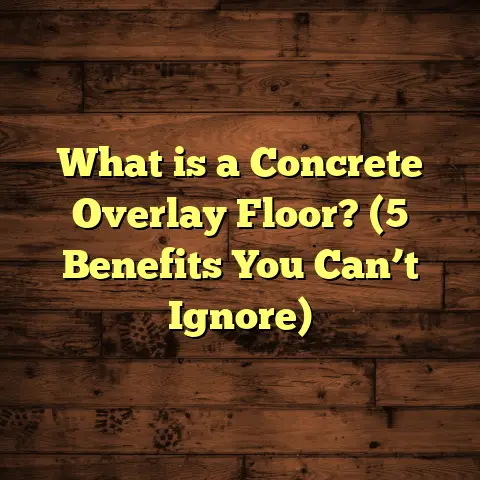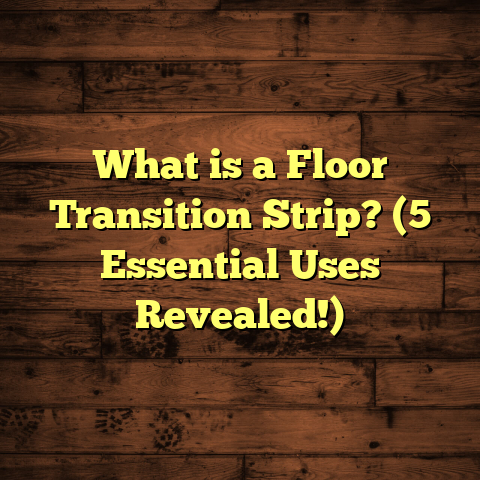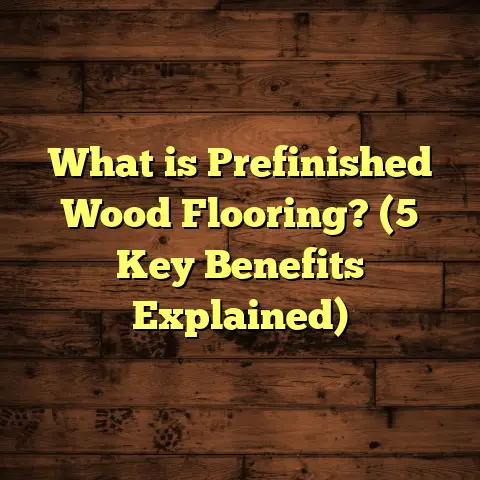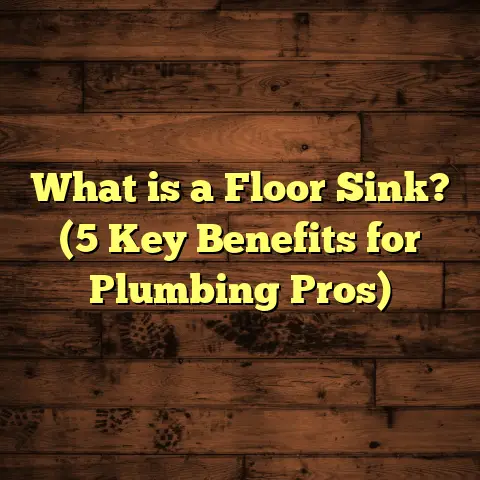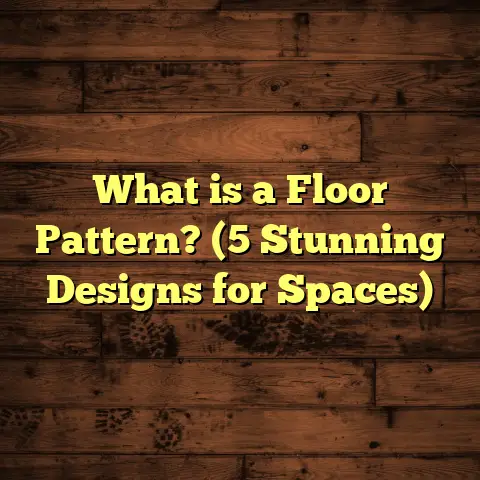What Is Vinyl Flooring Planks? (5 Facts You Must Know!)
I want to share something I see all the time, especially when clients come to me looking for new flooring: they often confuse vinyl flooring planks with laminate or hardwood. It’s a mistake that causes wasted time, frustration, and sometimes costly wrong purchases. A lot of folks think vinyl is just the cheap, flimsy flooring from the past—or they lump it together with laminate. But vinyl flooring planks today are a completely different animal. They’re durable, stylish, and often a better fit for many spaces than wood or laminate.
If you’ve ever wondered what vinyl flooring planks really are, how they work, and why so many people—including me—recommend them, then you’re in the right place. I’m going to walk you through everything I know, based on years of installing floors, working with clients, and watching this product evolve.
What Is Vinyl Flooring Planks?
Let’s start with the basics: What exactly are vinyl flooring planks? Simply put, vinyl flooring planks are individual strips of flooring made primarily from synthetic materials designed to look like wood planks. Instead of being one big sheet of vinyl, these planks come in pieces that you install side by side, just like real hardwood floors.
Vinyl plank flooring is made up of several layers stacked together:
- Wear Layer: This is a clear top coat that protects the floor from scratches, stains, and fading. It’s what you walk on every day.
- Design Layer: This layer has a high-resolution printed image that mimics natural wood grains, knots, and textures.
- Core Layer: This is where different types of vinyl flooring vary. Some have flexible vinyl cores; others use rigid cores like WPC (Wood Plastic Composite) or SPC (Stone Plastic Composite).
- Backing Layer: This gives the planks stability and sometimes adds cushioning.
The result is a floor that looks a lot like hardwood but is more resistant to scratches, moisture, and dents.
How Did Vinyl Planks Get So Popular?
Years ago, vinyl was seen as a cheap alternative that didn’t last long. But thanks to advances in manufacturing technology, vinyl planks today can replicate the look and feel of hardwood almost perfectly.
In fact, according to industry data from Freedonia Group and other market research firms, vinyl plank flooring sales have grown by over 7% annually in the U.S. since 2018, outpacing laminate and some hardwood categories. The rise is fueled by homeowners wanting affordable durability without sacrificing style.
My First Encounter with Vinyl Planks
I remember my first big project with vinyl planks about 10 years ago. A client wanted a kitchen floor that wouldn’t get damaged by spills or dropped utensils but still looked like warm wood. We went with SPC vinyl planks because of their waterproof core. The installation was quick, the floor looked stunning, and best of all—it held up flawlessly for years.
That project opened my eyes to how versatile and resilient this flooring type can be.
5 Facts You Must Know About Vinyl Flooring Planks
Now let me share five important facts about vinyl flooring planks that every homeowner or contractor should know.
1. Vinyl Planks Are Truly Waterproof (Not Just Water Resistant)
One of the biggest misconceptions I’ve found is people thinking vinyl flooring is water-resistant but not waterproof. The truth is, most vinyl planks—especially SPC and WPC types—are fully waterproof.
Why does this matter? Because moisture is the enemy of many traditional floors like hardwood and laminate. If water seeps in, boards warp or swell.
I once worked on a basement project where flooding was an issue during rainy seasons. After installing SPC vinyl planks with a tight click-lock system and proper sealing around edges, the client reported zero damage even after minor seepage inside.
According to the National Wood Flooring Association (NWFA), vinyl plank floors can endure up to 72 hours of direct water exposure without swelling or delaminating when installed correctly.
This makes vinyl planks perfect for:
- Bathrooms
- Kitchens
- Basements
- Laundry rooms
- Even commercial spaces like cafes or gyms where spills are frequent
Have you ever had hardwood floors buckle from water damage? Vinyl planks eliminate that worry almost entirely.
2. Realistic Wood Appearance with Multiple Texture Options
One thing I hear from clients again and again is amazement at how real vinyl plank floors look now.
Manufacturers use high-definition printing combined with embossing techniques that create textures you can see and feel. Some brands even replicate fine details like saw marks or knots found in natural wood.
Here’s some interesting data from a consumer survey by Home Flooring Pros:
- Over 80% of respondents said their vinyl plank floor looks just like real hardwood.
- About 65% preferred vinyl planks over laminate because the surface feels softer and warmer underfoot.
- Vinyl planks come in various finishes like matte, semi-gloss, or gloss — offering options for different styles.
From light oak to dark walnut and even exotic woods like hickory or teak, there’s a wide range of visuals available.
I had a client who wanted a rustic farmhouse look on a budget. We chose vinyl planks with an embossed hand-scraped finish. The results were stunning enough that neighbors kept asking if it was real wood!
3. Installation Can Be DIY-Friendly but Requires Careful Preparation
Many homeowners tell me they want to install vinyl plank floors themselves because it sounds easy—just click and lock the planks together over your old floor or subfloor. While it’s true that installation is simpler than hardwood or tile, it still requires proper preparation and techniques to avoid problems later.
Here are some tips I always share:
- Make sure the subfloor is clean, dry, level (within 3/16 inch over 10 feet), and free of debris.
- Use an underlayment recommended by the manufacturer for extra cushioning or moisture barriers.
- Leave expansion gaps of about 1/4 inch around walls to allow for natural floor movement as temperature changes.
- Cut planks carefully using a utility knife or vinyl cutter.
- Stagger end joints properly to create a natural look and added strength.
I’ve seen DIY jobs go wrong when people skipped subfloor leveling or didn’t account for expansion gaps. Floors buckled or popped loose within weeks.
On the flip side, I also helped several clients who successfully installed their own floors by following these guidelines closely.
One tool I use for planning jobs—and suggest to DIYers—is FloorTally. It helps calculate how many planks you need plus costs based on your room size and your chosen core type. It also factors in waste (usually about 7%) so you don’t run short mid-project.
This kind of planning can save you headaches and money.
4. Durability Depends on the Core Type You Choose
Vinyl plank flooring isn’t just one product—it varies widely depending on the core construction.
Here are three main types:
- Flexible Vinyl Core: Thin, soft planks that bend easily; usually cheaper but less durable.
- WPC (Wood Plastic Composite): Thicker core with some cushion; good for comfort but can dent under heavy furniture.
- SPC (Stone Plastic Composite): Dense, rigid core made with limestone powder; very tough and highly resistant to dents and scratches.
In my work, I usually recommend SPC for places with heavy foot traffic or commercial use because it stands up better to wear and tear. WPC works well in residential rooms where comfort matters more than extreme durability.
For example, one retail client switched from flexible vinyl to SPC after noticing frequent damage from carts rolling over their floor. The SPC upgrade extended their floor life by over five years.
Here’s what industry data shows about durability:
| Core Type | Scratch Resistance | Dent Resistance | Expected Lifespan (years) |
|---|---|---|---|
| Flexible Vinyl | Medium | Low | 5 – 10 |
| WPC | High | Medium | 10 – 15 |
| SPC | Very High | Very High | 15 – 20+ |
5. Maintenance Is Simple but Still Important
I often get asked if vinyl plank floors require any special care. The answer is yes—they’re easier than most floors but not “set it and forget it.”
Here’s what I tell clients:
- Sweep or vacuum regularly to remove grit that can scratch the surface.
- Mop with water and manufacturer-approved cleaners; avoid harsh chemicals or abrasive scrubbers.
- Use furniture pads under legs to prevent dents.
- Clean up spills quickly to avoid staining or damaging the wear layer.
- Avoid dragging heavy objects across the floor.
One client learned this lesson the hard way when they used bleach-based cleaner on their floor—it dulled the finish fast. After switching to gentle products, their floor looked brand new for years.
Vinyl flooring manufacturers often provide maintenance guides tailored for their products, which I recommend reviewing before purchasing.
Breaking Down Costs: What Should You Expect?
Now let’s talk money—because cost always comes up when choosing flooring.
Vinyl plank flooring generally costs less upfront than hardwood but more than basic sheet vinyl or carpet. Prices vary based on brand, core type, thickness, design complexity, and installation method.
From my experience:
| Type | Material Cost per Sq Ft | Installation Cost per Sq Ft | Total Cost per Sq Ft |
|---|---|---|---|
| Flexible Vinyl | $2 – $3 | $1 – $3 | $3 – $6 |
| WPC | $3 – $5 | $2 – $4 | $5 – $9 |
| SPC | $3.50 – $6 | $3 – $5 | $6.50 – $11 |
Installation costs vary widely depending on region and complexity but usually include subfloor prep, underlayment, labor, and cleanup.
I always recommend budgeting for about 7% extra material for cuts and waste (FloorTally does this automatically).
How I Use FloorTally to Manage Costs
FloorTally has become my go-to tool for budgeting flooring projects accurately without juggling multiple quotes or guesswork. By entering room dimensions, product type (flexible/WPC/SPC), waste factor, labor rates in my area, and other options, I get a detailed cost estimate instantly.
This helps me:
- Give clients realistic budgets upfront.
- Avoid ordering too much or too little material.
- Compare different product options side-by-side.
- Plan installation schedules better based on project size.
It’s saved me hours per project and made communication with clients smoother because we’re all on the same page financially before work starts.
Real-Life Case Studies
Case Study #1: Kitchen Remodel with SPC Vinyl Planks
A couple in Portland wanted a kitchen floor that could handle spills yet look like natural wood. We chose SPC vinyl planks with a matte oak finish. The subfloor was uneven so we installed a leveling compound first.
The installation took two days including drying time for leveling. The clients loved how easy it was to clean after cooking messes. One year later—no signs of wear or water damage despite heavy daily use.
Case Study #2: Basement Renovation Using WPC Vinyl Planks
In Minnesota’s cold climate, a client wanted warm-looking floors in their basement rec room but worried about moisture issues. WPC vinyl planks were installed over a moisture barrier underlayment.
The thicker core provided some insulation against cold concrete below. After two winters of freeze-thaw cycles and occasional flooding in nearby pipes, the floor remained intact without buckling or stains.
Case Study #3: Retail Store Upgrading from Laminate to SPC
A local retailer had laminate flooring that chipped easily under cart wheels causing frequent repairs. We replaced it with commercial-grade SPC vinyl planks featuring enhanced scratch resistance.
The floor installation was completed overnight to minimize downtime. Six months later, no damage was reported despite heavy foot traffic and rolling carts daily.
Addressing Common Questions About Vinyl Flooring Planks
Q: Can I install vinyl planks over existing hardwood?
A: Yes! As long as the hardwood is level and securely fastened, you can float vinyl planks over it using an underlayment designed for that purpose. Just make sure to leave expansion gaps around edges.
Q: How thick should my vinyl planks be?
A: Thickness ranges from about 3mm (flexible) up to 8mm+ (SPC). Thicker planks offer better durability and comfort but cost more.
Q: Will pets damage vinyl flooring?
A: Because of its scratch-resistant wear layer, vinyl holds up well against pets’ nails better than hardwood or laminate in many cases. Still recommend trimming nails regularly!
Q: Does vinyl off-gas chemicals?
A: Modern vinyl plank products comply with strict indoor air quality standards like FloorScore® certification ensuring low VOC emissions safe for homes.
My Final Thoughts After Years Working With Vinyl Flooring Planks
Vinyl flooring planks have proven themselves as versatile, durable choices suitable for almost any room—even those prone to moisture or heavy foot traffic.
They offer:
- Realistic wood looks without price shock
- Waterproof construction
- Various core options for comfort vs durability
- Simpler installation compared to hardwood
- Easy maintenance routines
If you’ve hesitated because you thought all vinyl was cheap or low quality—it’s time to reconsider based on today’s technology and products available.
Would I put them in my own home? Absolutely—and I have! From kitchens to basements to busy commercial spaces, they’ve stood up beautifully every time.
If you want help deciding which type fits your space best—or how much material you’ll need—I’m happy to share more insights or help you run numbers using tools like FloorTally so your budget stays tight without surprises down the road.
Got questions? Just ask—I’m here for all things flooring!
